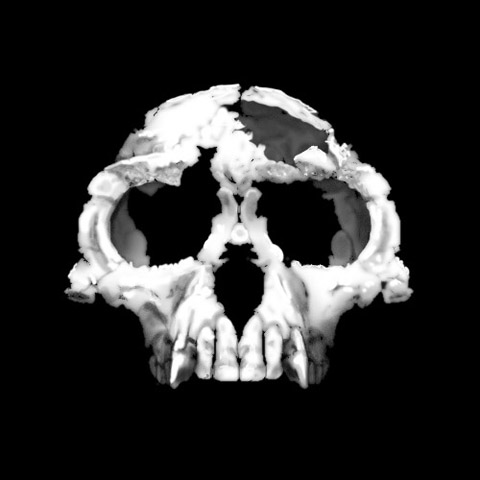Recent discoveries have challenged many of our traditional
views on the origin of our species.
The discovery of Ardipithecus
ramidus, nicknamed “Ardi,” in 2009 contradicts traditional theories of
early human evolution, such as the origin of bipedalism and our ideas on the
common ancestor of chimps and humans.
The long-help belief that bipedalism evolved because grasslands forced
early hominids to walk across open territory, the “savannah hypothesis,” may be
incorrect; Ardi, from 4.4 million years ago, is our earliest example of a
bipedal hominid, and she lived in the woods. Another long-held belief, that the common ancestor of chimps
and humans was chimp-like, may also be false. Ardi’s wrists bent backwards, but chimpanzees’ wrists
cannot; this may indicate that this supposedly ancestral trait may actually be
derived.
 |
| Ardi's skull (from http://upload.wikimedia.org/wikipedia/commons/e/e1/Ardi.jpg) |
The discovery of “Flo,” a member of Homo floresiensis, challenges our idea that intelligence requires a large brain. Flo, who lived 90,000 to 14,000 years ago, was 3.3 feet tall, bipedal, and had a brain one-third the size of a modern adult human’s brain. Despite this small brain, Flo’s people had stone tools and fire. What she lacked in size, she made up for in complexity; CAT scans used to restructure Flo’s brain show that it had unique and intricate folding. In this case, size doesn’t matter.
 |
| Flo's skull (from http://upload.wikimedia.org/wikipedia/commons/1/10/Homo_floresiensis.jpg) |
Recent genotype sequencing of Neanderthal DNA indicates that
modern humans may not have split off from other early hominids as decisively as
we would like to think. Instead,
there is much evidence that humans interbred with both Neanderthals and the
Neanderthals’ close cousins, the Denisovans. Humans and Neanderthals mated about 60,000 years ago in the
Middle East; their descendents travelled to Europe, Asia, and North America,
and today’s humans outside of Africa share one to four percent of their DNA
with Neanderthals. Similarly,
humans interbred with Denisovans in Eastern Asia; their descendents in New
Guinea share up to five percent of their DNA with Denisovans.
Future breakthroughs in both archaeology and technology are
sure to uncover even more exciting and detailed information on our origins.
- Samantha Masaki
Niemark, Jill. (2012). Homo sapiens, meet your new astounding family. Discover Magazine. Retrieved from: http://discovermagazine.com/2011/may/25-homo-sapiens-meet-new-astounding-family.
What is the source for this, I am interesting in reading more about this. Thanks!
ReplyDelete